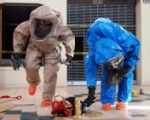
Bleach Is Best for Detoxifying Ricin, FDA Study Shows
Bleach significantly reduced the toxicity of ricin within five minutes, noted Lauren Jackson, a research food technologist with the U.S. Food and Drug Administration in Summit-Argo, Ill.
Help for a bioterrorist attack involving ricin may be as close at hand as the laundry shelf, according to a report presented at the 241st National Meeting and Exposition of the American Chemical Society (ACS). It concluded that ordinary household bleach appears to be an effective, low-cost, and widely available way to decontaminate food preparation surfaces in homes, restaurants, and processing plants that are tainted with ricin.
Ricin is a poison found naturally in castor beans, which are grown and processed throughout the world to produce castor oil. Although no longer widely used as a laxative, castor oil remains a key raw material in the manufacture of soaps, paints, dyes, inks, lubricants, hydraulic and brake fluids, and other products. Ricin occurs in the waste “mash” left behind after production of castor oil. Experts regard ricin as one of the most likely bioterror agents because it is so easy to obtain and so toxic, with no antidote. “This discovery is important because it provides a practical, readily available way to inactivate ricin on food processing equipment in the event of an intentional contamination event," said Lauren Jackson, Ph.D., who reported on the research. “It is the first study to explore ricin decontamination in the presence of food, and it shows that household bleach is effective.”
Jackson and colleagues prepared solutions of bleach and two other substances routinely used at food processing plants to disinfect counters, machinery, and other surfaces that may contain harmful bacteria or viruses. The other disinfectants were peroxyacetic acid (PAA) and so-called quaternary ammonium compounds. In one set of experiments, they tested the substances on discs of stainless steel smeared with milk-based infant formula, pancake mix, peanut butter, and other foods that contained ricin. They also tested the three disinfectants on a “control” solution containing ricin, but without any food, to make sure it was the disinfectants that inactivated ricin and not something present in the foods.
Household bleach turned out to be the most effective anti-ricin agent. Bleach significantly reduced the toxicity of ricin within five minutes, noted Jackson, a research food technologist with the U.S. Food and Drug Administration in Summit-Argo, Ill. Bleach completely eliminated ricin in the “control” samples using just a small amount. PAA also showed effectiveness, but less so than bleach.
ACS is a non-profit organization chartered by the U.S. Congress. With more than 163,000 members, the group is the world’s largest scientific society and a global leader in providing access to chemistry-related research through its multiple databases, peer-reviewed journals and scientific conferences. Its main offices are in Washington, D.C., and Columbus, Ohio.
Source: American Chemical Society